-
No-Code
Platform
-
Studio
No-code agentic platform delivering the fastest time-to-value and the highest ROI
-
Studio
-
AI-Native CRM
CRM
-
AI-Native CRM
New era CRM to manage customer & operational workflows
CRM Products -
AI-Native CRM
- Industries
- Customers
- Partners
- About
What is Marketing Campaign Management? The Definitive Guide
Updated on
October 17, 2025
15 min read
Boost Campaign ROI With Just One Platform. Try Creatio

Effective marketing campaign management is essential for standing out, connecting with audiences, and driving measurable results. However, it’s not just about launching creative ideas, but strategically planning, executing, and optimizing campaigns across multiple channels.
According to PwC, AI-driven marketing is expected to contribute up to 45% of the global economy by 2030, highlighting how technology is reshaping the way businesses manage and scale their marketing efforts. By combining strategic oversight with AI-powered tools, you can create more personalized, efficient, and impactful campaigns that deliver real business growth.
In this guide, we will walk you through each step of the marketing campaign management process and showcase how campaign management software, powered by AI, can enhance your marketing operations.
Key Takeaways
- Marketing campaign management encompasses the entire cycle of planning, executing, monitoring, analyzing, and continually optimizing campaigns to achieve measurable results.
- The process ensures that campaigns resonate with customers, communicate brand value, and maximize efficiency in budgeting and resource allocation.
- A successful campaign typically follows eight key steps: defining goals, identifying the target audience, selecting channels, outlining the budget, creating content, leveraging automation tools, launching the campaign, and analyzing results for ongoing improvement.
- AI-powered tools enhance every stage of campaign management by automating routine tasks such as content creation, audience segmentation, email scheduling, social media posting, and performance analysis - helping marketers reallocate budgets and improve content to maximize ROI.
- Creatio Marketing streamlines and accelerates campaign management by integrating AI agents directly into the platform, allowing teams to design, launch, and optimize campaigns more efficiently and intelligently.
What is Marketing Campaign Management?
Marketing campaign management is the process of planning, executing, monitoring, and analyzing campaigns across multiple channels, including digital, social, traditional media, advertising, and email. It streamlines and coordinates every stage of the campaign lifecycle, from initial concept development to performance evaluation and beyond.
The primary goal of a marketing campaign is to motivate the target audience to take a specific action, such as making a purchase, registering for an event, or upgrading a service. Effective campaign management supports this objective by leveraging audience insights to design targeted messaging, personalized content, and engaging experiences that drive the desired response.
To conduct comprehensive campaign management at scale, you need marketing automation systems that help build multichannel marketing campaigns and track and analyze their performance.
Why is Marketing Campaign Management Important?
The campaign management process ensures your marketing campaigns resonate with customers, highlight your brand’s value, and optimize budgeting and resource allocation. If you want to move away from isolated marketing activities and transform your efforts into a cohesive, customer-centric experience, you need to develop a comprehensive, data-driven strategy. This is where marketing campaign management shines.
For example, consistent campaign management can help an electric car manufacturer share a clear, unified message about sustainability across the right channels. Without it, marketing initiatives can become scattered, with social media campaigns, emails, and promotions focusing on different goals instead of reinforcing one message.
How to Plan a Successful Marketing Campaign in 8 Steps
Marketing campaign management provides a structured workflow for planning and executing successful campaigns. This framework helps streamline the marketing team’s efforts while ensuring a consistent, customer-focused experience.
Here’s a step-by-step guide on how to plan a successful marketing campaign:

Step 1. Determine campaign goals
Every marketing campaign starts with the question, “What do we want to accomplish?”. Most companies share the same business goals: to raise brand awareness, generate leads, build a good reputation, and foster customer loyalty. It can be helpful to start with one of these broader goals and then hone it into a specific and measurable campaign objective.
For instance, if your initial goal is to increase brand awareness, you might refine it to: “Achieve X industry media mentions, X social media mentions, and gain X new followers within one month.” This specific campaign objective outlines a clear direction and defines the key metrics to measure success.
Step 2. Analyze and segment your target audience
Understanding your audience is a crucial part of campaign management.
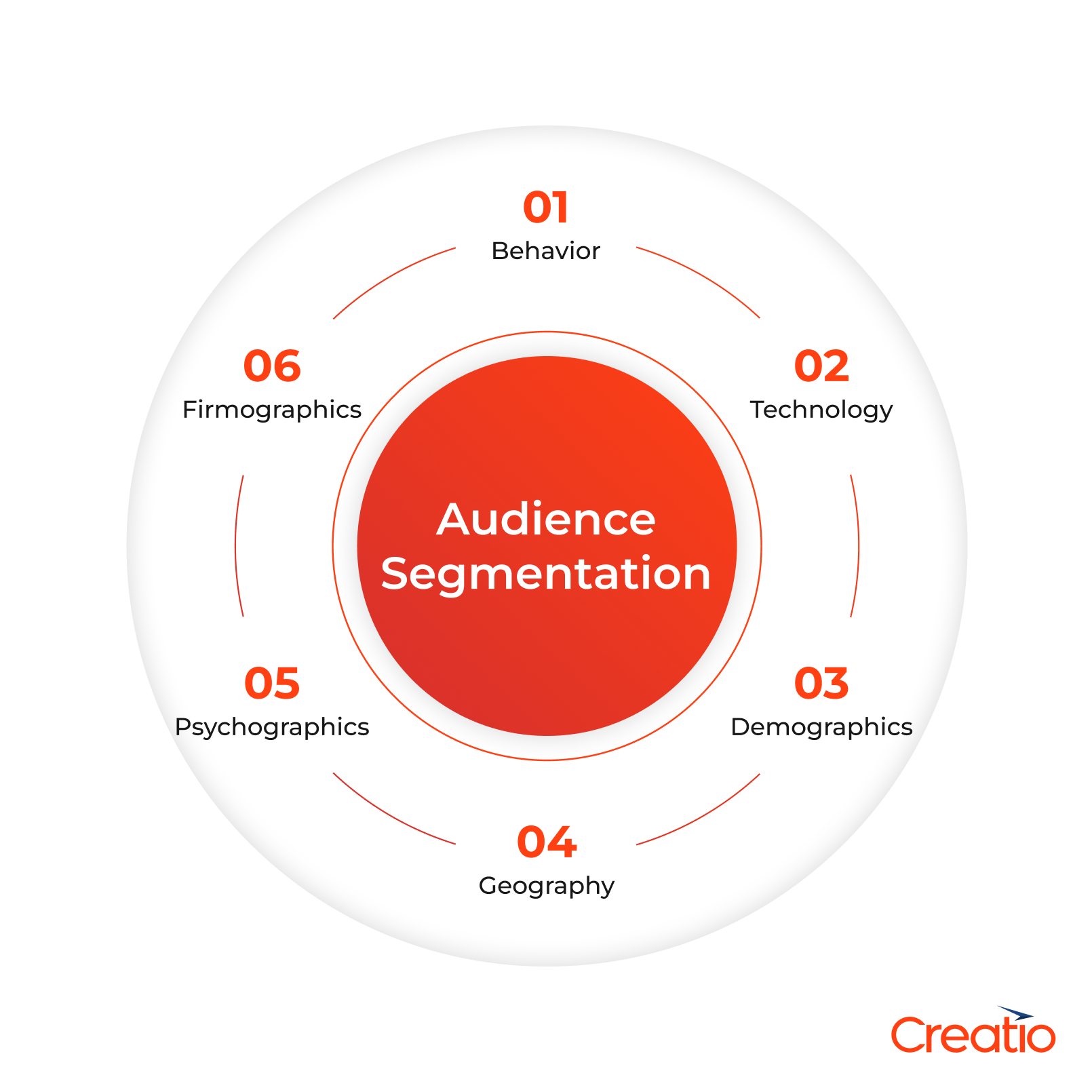
Audience segmentation is used to organize potential customers into distinct groups that share similar characteristics, behaviors, or needs, allowing marketers to tailor messages and offers that resonate more effectively with each segment.
Some of the factors that influence segmentation include:
- Demographic data: age, gender, education, occupation, and other relevant information.
- Geographic location: country or region.
- Firmographic data: company size, industry, revenue, and organizational structure - particularly important in B2B marketing.
- Psychographic factors: interests, lifestyle, pain points, and personal preferences.
- Behavioral factors: buying habits, purchase frequency, brand loyalty, and the decision-making process of customers.
- Technographic data: devices, platforms, and channels customers use to interact with your campaigns.
- Other criteria: stage in the customer journey, preferred communication channels, or responsiveness to specific campaign types.
Examining these factors enables campaign managers to understand potential customers and categorize them into target audience segments. This process can be supported by marketing campaign management tools powered by AI, which automatically analyze customer data and segment your audience into distinctive groups. Thanks to AI support, you can analyze large volumes of data much faster and uncover patterns and relations that a human-only team might miss.
According to the Digital Marketing Institute, 45% of surveyed marketers believe that the biggest impact will be achieved by implementing AI to enhance the accuracy of segmentation and targeting.
Step 3. Design the customer journey and determine the channels and content format

A depiction of general customer journey stages
Understanding your target audience enables you to plan a sequence of actions that will lead them to make a purchase. This sequence is referred to as the customer journey and is often visualized in campaign management tools as a customer journey map, a visual schematic representation of all the events that turn a person into a loyal customer.
For example, let’s say a person comes across your company’s post on LinkedIn. They find it interesting and follow the profile and then see an announcement of the webinar you’re planning. They visit the page to register, but get distracted and fail to complete the process. Later, they see an ad promoting the webinar and sign up for it. The webinar convinces them to try the product – and the rest is the responsibility of the Sales team.
In an ideal world, the process would look like this: social media engagement, webinar registration, and purchase. But, as you see, it involved additional steps across multiple platforms. And we didn’t even consider audience segmentation in our example – a customer who doesn’t use social media would have a different purchasing journey.
Based on customer journeys, you can determine channels for the campaign and content formats. Examples of marketing channels include social media platforms, newsletters, influencers, online and traditional media, websites, and advertising.
As for content formats, these can include paid ads, videos, articles, infographics, and other types of media. Determining formats before you start designing the content itself helps you plan resources more effectively. For instance, if you want to launch a video-heavy campaign but don’t have a video producer and editor on the marketing team, you’ll have to outsource these tasks.
This step provides a clear outline of marketing tasks to complete within a specific timeframe.
Case Study
Discover how Blueprint automation used Creatio Marketing’s intelligent audience segmentation capabilities to personalize marketing campaigns and streamline lead generation.

Step 4. Revise your resources and determine the marketing budget
By this stage, you should have a clear understanding of the resources your campaign requires. These can be divided into three main categories:
- Knowledge and skills (professional resources) encompass the expertise required to execute the campaign effectively. For example, for an influencer-heavy campaign, you may need to hire or outsource influencer marketing managers.
- Marketing campaign tools. You’ll need software for content creation, marketing automation, and analytics. To optimize costs, choose platforms that integrate multiple functions, such as automation and performance tracking.
- Paid marketing budget involves ad spend funds that you can allocate for both digital and traditional advertising.
Now you are ready to build the campaign budget. Use data from previous paid campaigns, freelance or agency costs, and typical customer acquisition expenses – it will help campaign managers make more accurate and realistic projections.
Some marketing teams don’t have the freedom to determine their budgets and must work with the numbers suggested by the executive department. Engaging in discussions about the company’s revenue and budget with stakeholders can ensure realistic expectations. To bridge this gap, campaign managers can explore cost-effective resources like free infographics generated with AI, along with other free formats, such as videos and images, to enhance their campaign while staying within budget.
Step 5. Create content
The campaign content you create should be based on the customer research you carried out previously and designed to be:
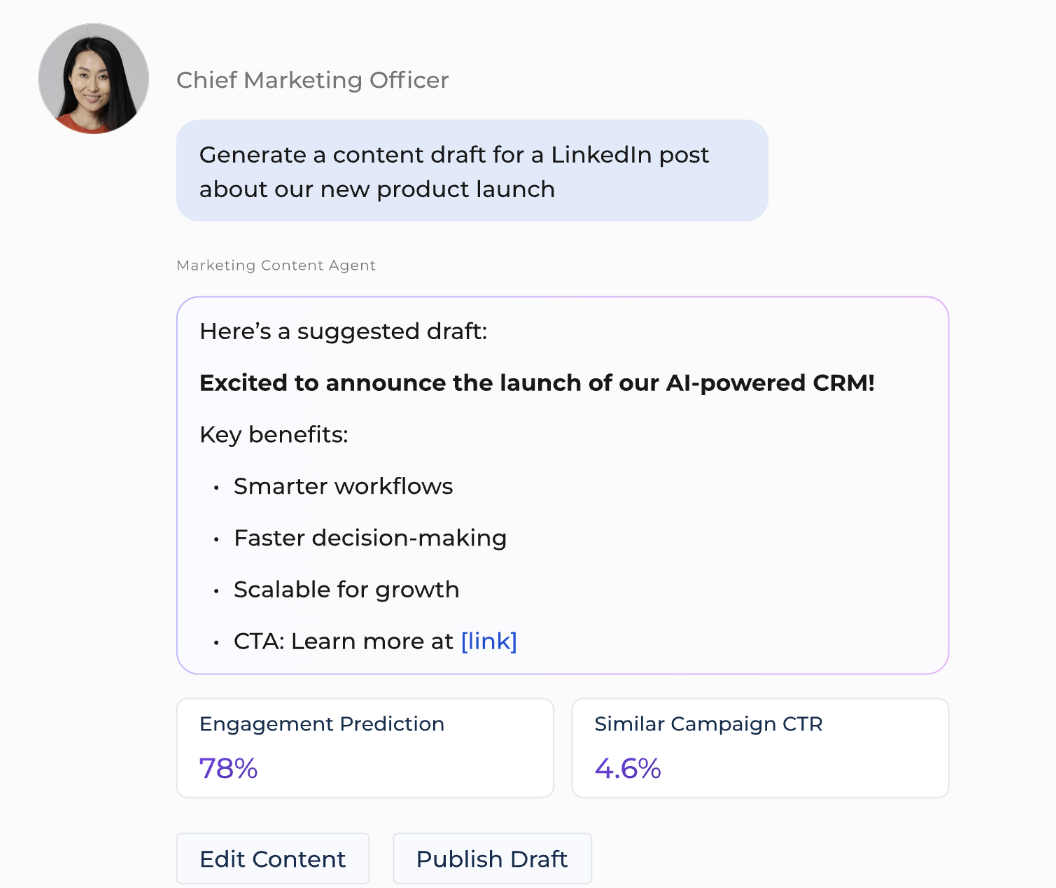
- Personalized. The content you create should be based on your audience data and incorporate language, visual references, messaging, and narratives that resonate with them. For example, if you’re promoting vitamins, a health-conscious audience will want to know about the ingredients, while parents will also be interested in taste. According to McKinsey, AI-powered personalization in marketing can help lower customer acquisition costs by as much as 50%, increase marketing ROI by 10-30%, and boost revenue growth by 5-15%.
- Valuable. Aim to provide your audience with insights that extend beyond mere product descriptions. Offer informative and helpful content that demonstrates how your product fits within the larger context of the industry landscape and your audience's lives.
- Actionable. While not every asset needs to lead to a purchase, ensure each content piece moves a person further down the customer journey. For example, an informative article can end with a CTA to sign up for a newsletter. This way, you ensure that all marketing activities are coherent and serve the ultimate business goals.
- Focused. The content’s role is to guide customers through the journey one step at a time. For this reason, keep your assets focused on one action.
- Engaging. Content that evokes emotions is much more memorable and effective in prompting actions, so make sure your campaign makes people feel something.
- Search-optimized. Your content should be easy to find – this can be ensured by selecting the relevant marketing channels and spaces for your audience and optimizing content for marketing and search engine algorithms.
The content creation process can also be significantly enhanced and scaled using generative AI, which enables marketing teams to quickly produce personalized copy, visuals, and campaign assets. By utilizing AI to generate initial drafts of emails, social media posts, or ad variations, marketers can concentrate on the creative part of the campaign and innovation. Moreover, AI-driven insights help tailor messaging based on audience behavior and preferences.
According to Gartner, by the end of the year 2025, 30% of all outbound marketing content will be fully AI-generated.
Step 6. Embrace marketing automation
Many routine marketing operations can be automated with the help of proper campaign management software, which is currently often supported by AI tools. Leveraging marketing automation tools doesn’t just save time for your team – it also enables quicker responses to customer actions and ensures your prospects have a smooth experience with the company.
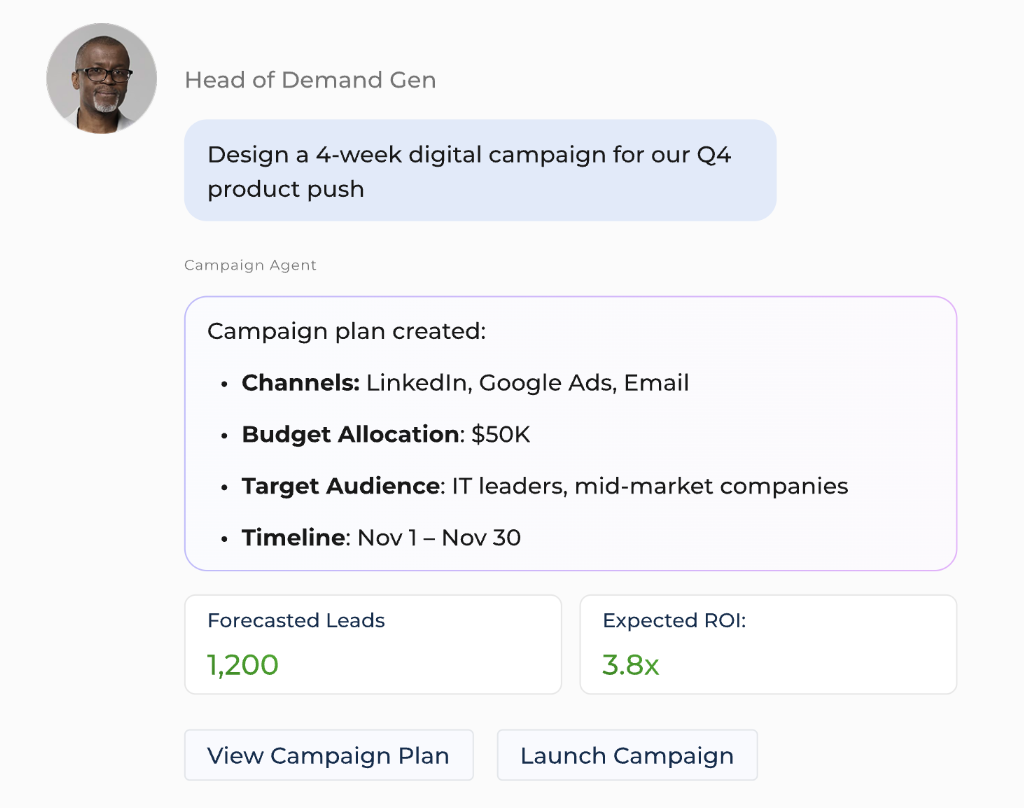
The most common example is email automation software. Imagine a customer who shares their email address and gets regular emails triggered by specific actions or time intervals - all without the marketing team having to manually send each message. This automation not only saves time but also ensures consistent communication and nurtures customer relationships more effectively.
Marketing automation software can focus on a specific type of marketing (for example, Mailchimp for email campaigns, Buffer for social media management, or ActiveCampaign for marketing campaign management) or enable wide adoption of automation across your marketing operations (for example, Creatio Marketing for end-to-end marketing automation). Evaluate your goals and use cases to choose the most suitable solutions.
Set up trigger events and follow-up actions in the software of your choice in line with the customer journey. Once you launch the campaign, you can change these settings as you learn more about customer behavior. By choosing an AI-powered marketing automation tool, you can also leverage AI to optimize timing, content, and channel selection, ensuring that campaigns reach the right audience with the right message at the right moment.
Almost 90% of marketers surveyed by Mailchimp believe that to meet customer expectations and increase their satisfaction, their organizations must increase the use of AI-powered marketing automation.
Step 7. Launch the campaign
At this stage, you deliver all the content to the appropriate channels and engage with your audience. However, launching the campaign shouldn’t be limited to clicking “Publish.”
Take each campaign as an opportunity to run marketing tests. For example, doing A/B tests for the campaign’s landing page demonstrates which copy and layout works better for conversion, resulting in more leads and valuable insights you can utilize in the next campaign. With AI-powered tools, A/B testing becomes even easier and faster, as AI can automatically generate variations, analyze results, and identify the most effective elements.
You can start these experiments prior to the wide rollout or run them simultaneously. Just make sure you don’t perform several tests for the same asset at once, otherwise, you won’t be able to attribute the results properly.
Step 8. Analyze results and optimize campaigns on the go
Use analytics tools to compare your results with the marketing goals established at the start of your campaign to see what’s working and what needs improvement. Continuously measure campaign performance to safeguard yourself against surprise failures at the end of the campaign. Regular updates give you the flexibility to adjust your campaign as it progresses rather than being faced with inadequate results once it ends.
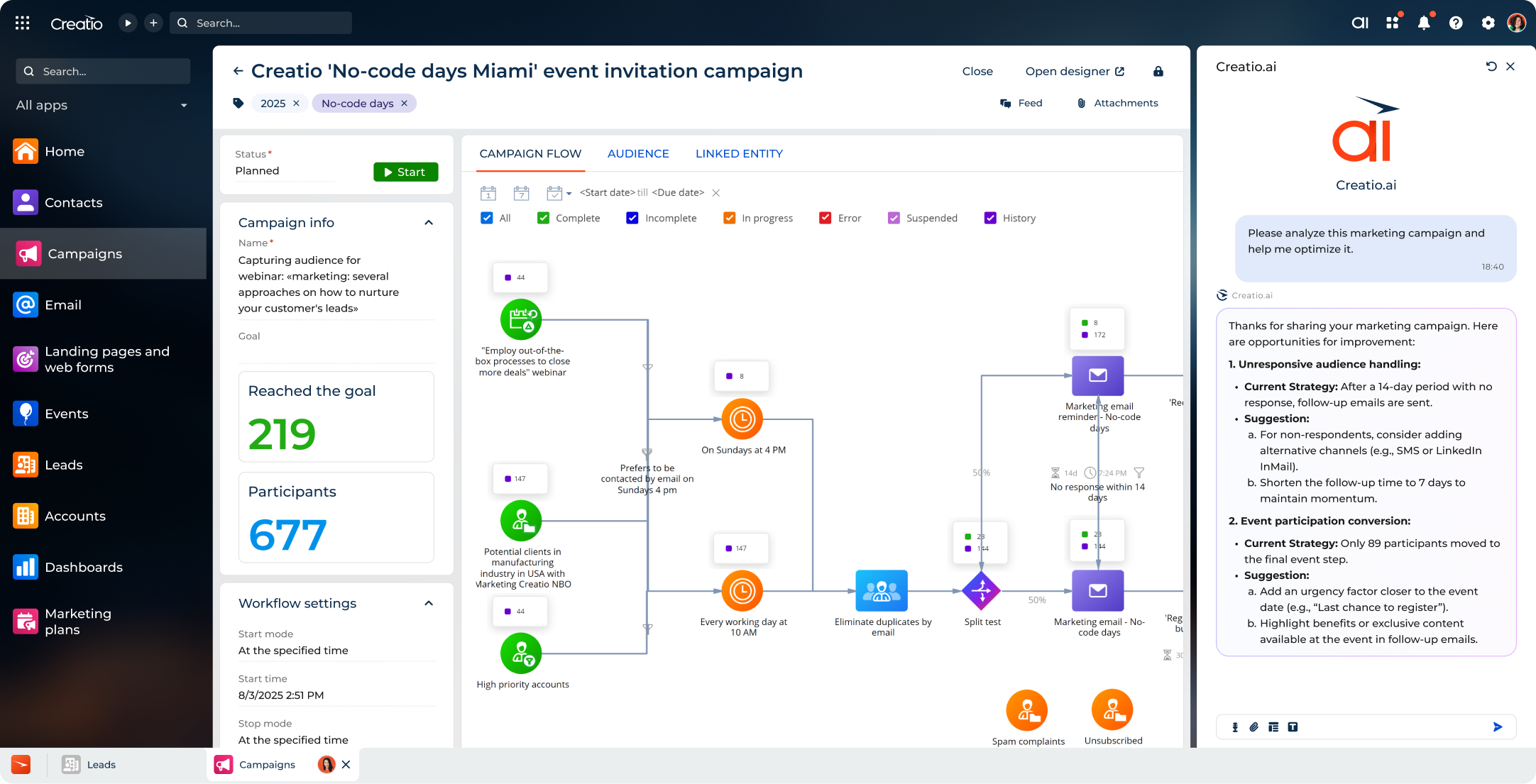
Utilize AI for marketing to continuously monitor, analyze, and report campaign performance across all marketing channels. By using AI-powered tools, the marketing team doesn’t have to frequently check and manually review campaign data to draw conclusions. Instead, they can rely on AI to track campaigns' progress, provide comprehensive performance reports, and, in cases of advanced tools, even recommendations on how to improve campaign efficiency.
AI-powered tools, such as AI agents for marketing, can also optimize campaigns by reallocating budget to the best-performing ads, quickly pivoting to more effective channels, and generating variations of content and visuals to replace those that are performing poorly.
Moreover, by analyzing the data, leveraging AI insights, and identifying mistakes and weaknesses, you can create more impactful campaigns in the future. Just remember, if you’re analyzing data that may qualify as personal information, various data privacy laws, like the GDPR, require you to create a privacy policy that discloses the use of user data.
The Role of AI in Campaign Management
We’ve already discussed how AI can enhance content creation and A/B testing. In practice, AI supports marketing professionals across the entire campaign management process, assisting with campaign planning, execution, and optimization with greater efficiency and precision.
The use of AI in marketing is no longer a futuristic concept—it’s becoming a core driver of business growth. According to Creatio’s State of AI Agents and No-Code Global Report, 67% of surveyed business leaders are already exploring the use of AI in marketing, sales, and service to support frontline teams’ productivity and efficiency.
Here are some key ways AI supports campaign management:
- Audience segmentation and targeting: AI analyzes customer data to create precise audience segments based on demographics, behavior, preferences, and engagement history.
- Personalization at scale: AI tools dynamically tailor campaign elements, offers, and messages for individual users across channels, increasing engagement and conversion rates.
- Predictive analytics: By forecasting customer behavior and campaign performance, AI helps marketers allocate budgets effectively and anticipate which strategies are most likely to support campaign success.
- Performance optimization: AI continuously monitors multiple campaign metrics and automatically adjusts ad spend, budget allocation, or messaging in real time to maximize ROI.
- Workflow automation: From scheduling and sending emails to managing ad placements, AI automates campaign activities, reduces manual work, streamlines execution, and accelerates delivery timelines.
- Creative support: Generative AI helps develop ad copy, visuals, and campaign assets, enabling teams to produce high-quality content at scale while maintaining brand consistency.
The State of AI Agents & No-Code
Learn how 560+ leaders across the world use AI and no-code to drive innovation today
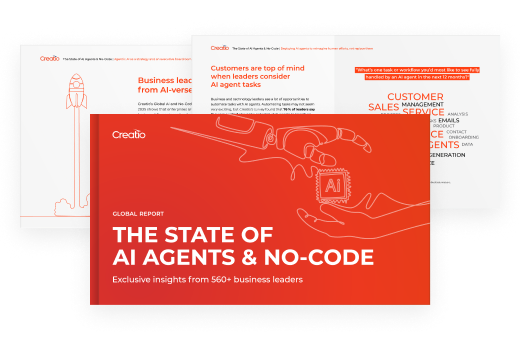
Benefits of Marketing Campaign Management
Effective campaign management delivers far more than just organized marketing efforts - it creates a foundation for stronger customer relationships and more effective resource allocation. Aligning strategy, campaign execution, and analysis, it enables marketing teams to work smarter, respond faster to market changes, and achieve greater impact with every campaign.
1. Improved organization and efficiency
Campaign management provides a clear structure for campaign planning, executing, and tracking. It helps teams coordinate tasks, set priorities, and avoid overlaps, resulting in streamlined workflows and better time management.
2. Consistent brand messaging
By unifying goals and creative direction, campaign management ensures that every marketing effort communicates a consistent brand message across multiple channels. This strengthens brand identity and improves audience experiences.
3. Data-driven decision making
Campaign management software collects and analyzes performance data, enabling marketers to make informed decisions about their strategies. With these insights, marketing teams can identify what works, refine underperforming strategies, and allocate resources more effectively.
4. Better resource allocation
With a structured approach, businesses can allocate budgets, talent, and tools more efficiently. Campaign management helps minimize waste, optimize spending, and ensure the highest return on investment for each campaign.
5. Stronger collaboration across teams
Campaign management software centralizes communication and planning, fostering collaboration between marketing, sales, creative, and analytics teams. This alignment ensures everyone works toward shared objectives with full visibility into progress.
Types of Marketing Campaigns
Marketing campaigns can be classified by the campaign's purpose or the main channel it uses. The standard classification includes the following types.

Product marketing
Purpose: Increase sales
This type of marketing campaign aims to position the product on the market and highlight its advantages, generating sales.
Brand marketing
Purpose: Boost brand awareness, recognition, and reputation
Do you know these Coca-Cola ads that don’t say anything about the taste of the drink? They just show people having fun together with a lot of Coke bottles around them. This is a great example of brand marketing – it aims to build a brand image rather than sell a specific product.
Content marketing
Purpose: Generate leads, build brand awareness, and improve customer retention
This type of campaign is defined by the medium rather than the marketing purpose. It entails creating video, audio, visual, and written content geared for various marketing outcomes.
Email marketing
Purpose: Increase recurring sales and nurture leads
Email marketing covers all the newsletters and automated emails your brand sends. It’s often used to take leads further down the sales funnel and generate recurring sales.
Paid marketing
Purpose: Reach new audiences
Advertising enables you to expand beyond your organic audience and reach new customers. Moreover, considering the challenges of social media algorithms and Internet saturation, paid marketing can sometimes be the most effective way to promote your product, even to your existing followers.
Enhance Marketing Campaigns with Creatio
Creatio Marketing is a new era marketing platform to accelerate the lead-to-revenue cycle with no-code and AI at its core. It enables businesses to gain a holistic view of their customers, run omnichannel marketing campaigns, orchestrate customer journeys, and streamline traditional and digital marketing campaigns.
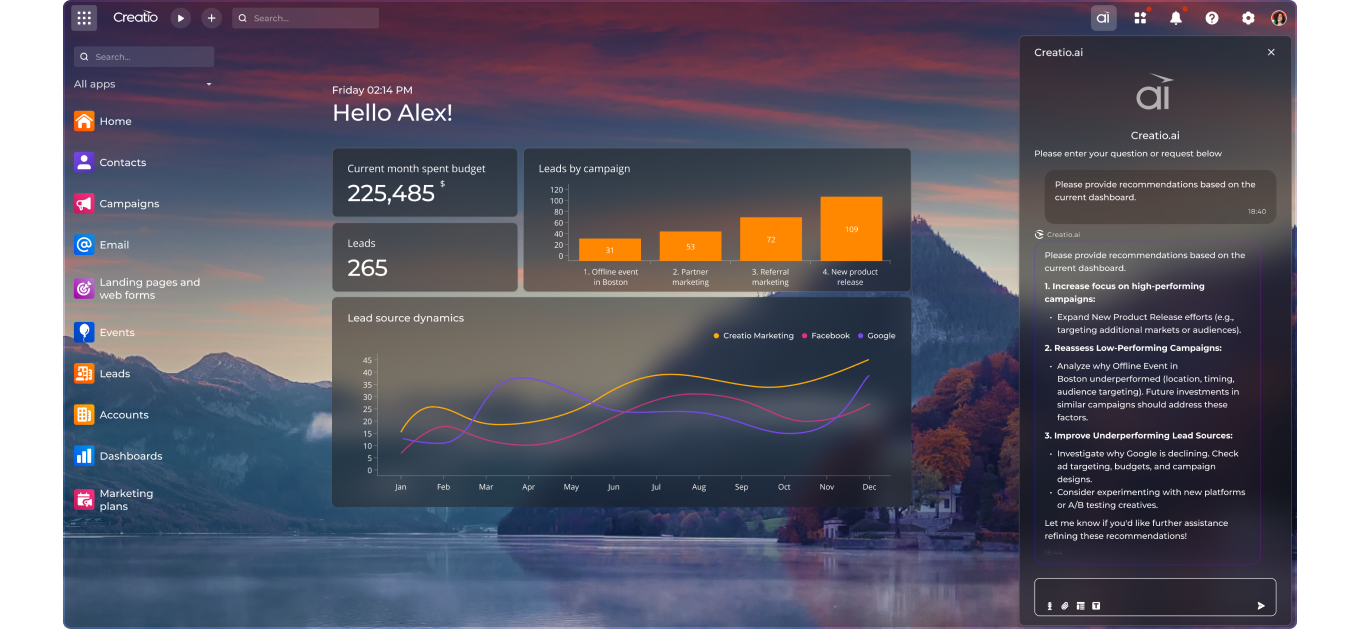
Creatio Marketing is built on a no-code platform that empowers business users to leverage a composable architecture, visual tools, and AI agents to create and customize marketing applications, workflows, and reports without requiring any coding experience. Creatio natively embeds Creatio.ai across the entire platform to redefine how marketers design, execute, and optimize campaigns by integrating AI throughout the entire marketing lifecycle.
Creatio offers best-in-class, ready-to-use AI agents for marketing automation and CRM applications, enhancing efficiency and enabling data-driven marketing strategies from day one. Marketing AI agents include Marketing Content Agent, Email Generation Agent, Campaign Agent, Lead Scoring Agent, and more.
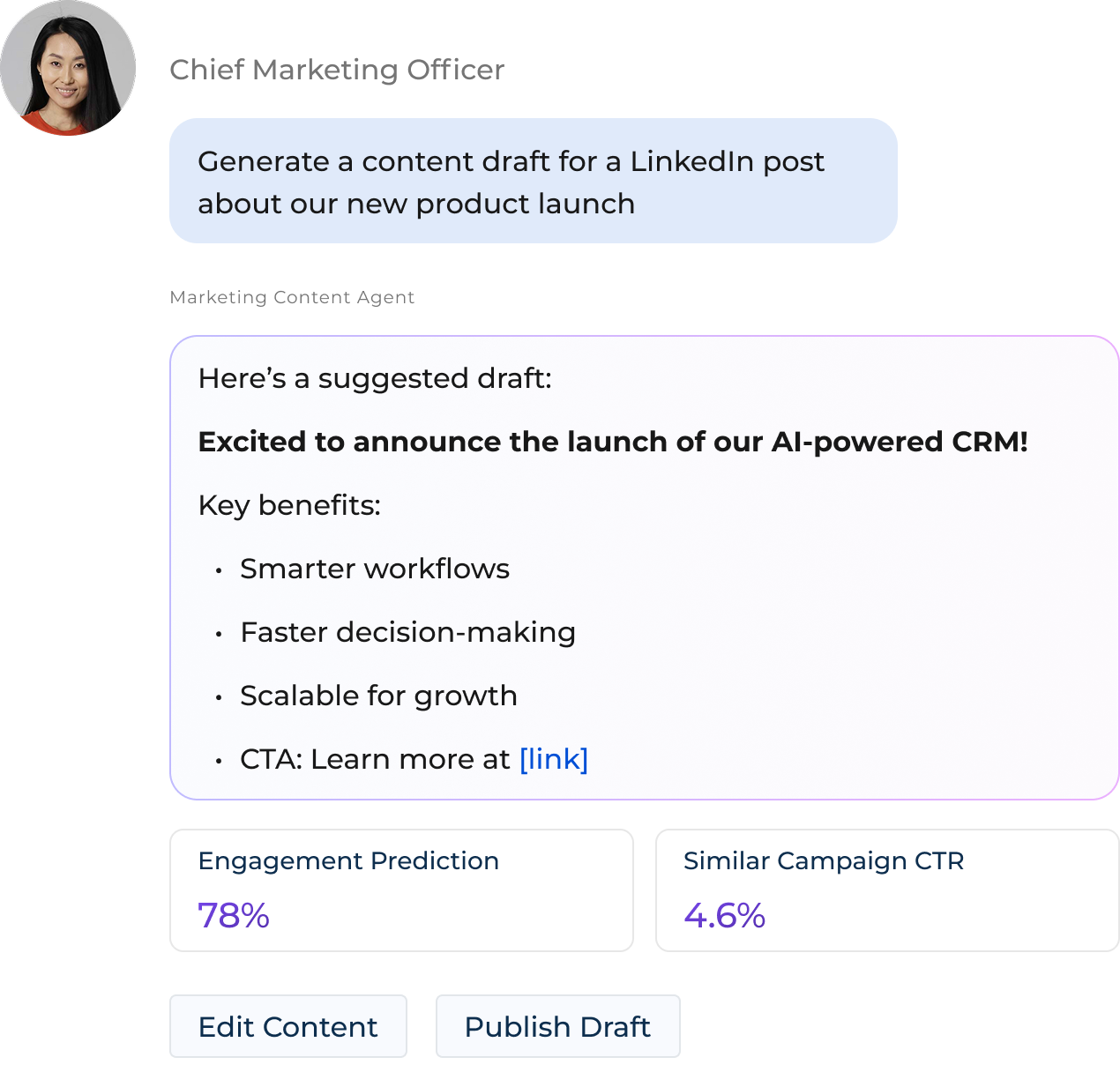
Creatio Marketing seamlessly combines AI agents with composable AI-native marketing applications. It enables marketing campaign managers to create multichannel campaigns using the intuitive visual campaign designer. The system supports setting up criteria for target conversion rates and campaign completion and defines conditions for transitioning between campaign stages.
Creatio Marketing offers a comprehensive customer perspective through a 360-degree customer profile, which includes contact and account data, as well as a complete omnichannel engagement history. It also provides features to budget, execute, and track marketing campaigns and projects of any complexity, with a rich visual campaign designer and intuitive analytics.
The Creatio platform also supports email marketing campaigns by providing tools for full-cycle automation, including rich email templates, a visual content designer, and A/B test optimization, all backed by powerful AI capabilities for maximum efficiency. Additionally, Creatio Marketing offers all-in-one digital ad campaign management, including ad campaign planning, tracking, and analytics, with extended dashboards that allow marketers to track and measure campaign performance.
Summary
Achieving marketing success doesn't require a Don Draper-like genius; there's no secret formula to a successful campaign. All you need is efficient planning and modern campaign management software that supports your processes. With this guide and Creatio Marketing, you’ll be able to run memorable, engaging campaigns with maximum efficiency.






















































